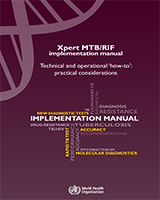A GeneXpert instrument can be positioned anywhere, from a peripheral clinic, mobile laboratory or doctor's office to a high-throughput reference laboratory. The selection of a site will depend on the testing workload and the efficiency of referral networks, and should take into consideration the infrastructure requirements, the human resources capacity and running costs.
In order to meet infrastructure requirements and optimize the throughput of an instrument and running costs, machines are often placed above the peripheral level, which requires establishment of reliable specimen or patient-referral networks. In general, while proficiency in conducting Xpert MTB/RIF is needed at the reference laboratory level in order to monitor and support a country's laboratory network, the Xpert MTB/RIF testing should not be placed solely in centralized reference laboratories since patients gain the greatest benefit from the test when it is placed as close as possible to the point of care.
Once the GeneXpert instrument is available, Xpert MTB/RIF assay does not require additional laboratory equipment, but the sophisticated nature of the device requires that certain conditions and infrastructure be present to ensure its efficient use. These considerations may limit where it can be positioned (see section 7.1 for details). The device needs:
a stable and continuous electrical supply to avoid interruptions to the procedure and the subsequent loss of results, waste of cartridges and possible damage to or failure of the modules;
to be secured against theft, particularly the accompanying computer;
an ambient temperature of 15–30 °C in the room where the instrument is placed;
adequate storage space for the cartridges with an ambient temperature of 2–28 °C;
trained staff to perform the test;
biosafety precautions similar to those needed for direct smear microscopy and as described in WHO's 2012 Tuberculosis laboratory biosafety manual.
17
When choosing where to place the Xpert MTB/RIF testing, the following issues should be considered:
the groups to be targeted for testing with Xpert MTB/RIF;
the diagnostic pathway or algorithm to be used, and the availability of other screening or diagnostic tests in the facilities and laboratory network;
the current or estimated case-load of the facility that cares for the targeted patient groups;
the existence and structure of the network for specimen transport and patients' referral;
the possibility of referring specimens for further susceptibility testing when rifampicin resistance has been detected;
the availability of adequate infrastructure;
the availability of dedicated personnel who can be trained, perform testing and keep equipment in good order;
the funding available for capital and running costs (as described in
section 7.3);
the availability of sufficient capacity to appropriately treat patients with TB and rifampicin-resistant TB who are detected.

